Abstract
The usual profile of indoor microbial aerosols probably has little meaning to healthy people. However, hazardous microbial aerosols can penetrate buildings or be generated within them; in either case, they can have significant adverse effects on human health. These aerosols can be controlled to some extent by eliminating or reducing their sources. In this regard, careful consideration should be given in building construction to the design of ventilation and air-conditioning systems and to the flooring material, so that these systems and the flooring material will not act as microbial reservoirs. It is evident that in spite of the considerable body of data available on indoor microbial aerosols, little is known of their true significance to human health except in terms of overt epidemic disease. Continued research is needed in this area, particularly in respect to situations of high risk in such locations as hospitals and schools for young children.
Full text
PDF
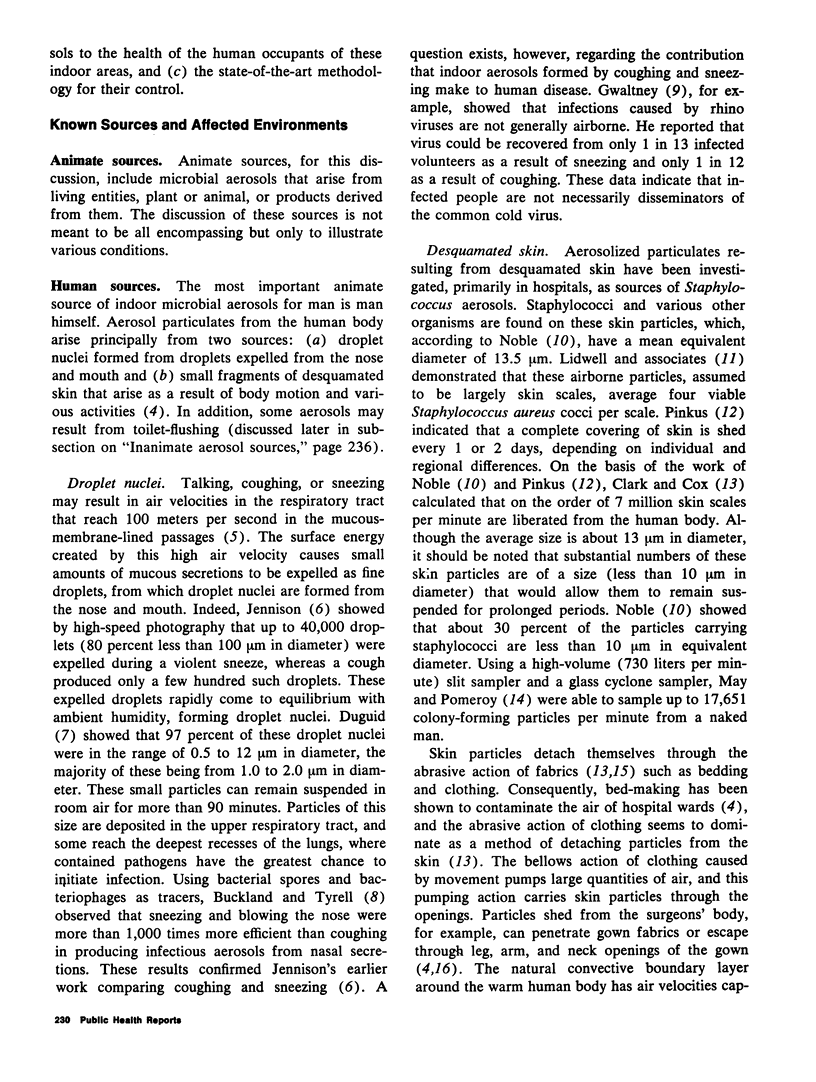
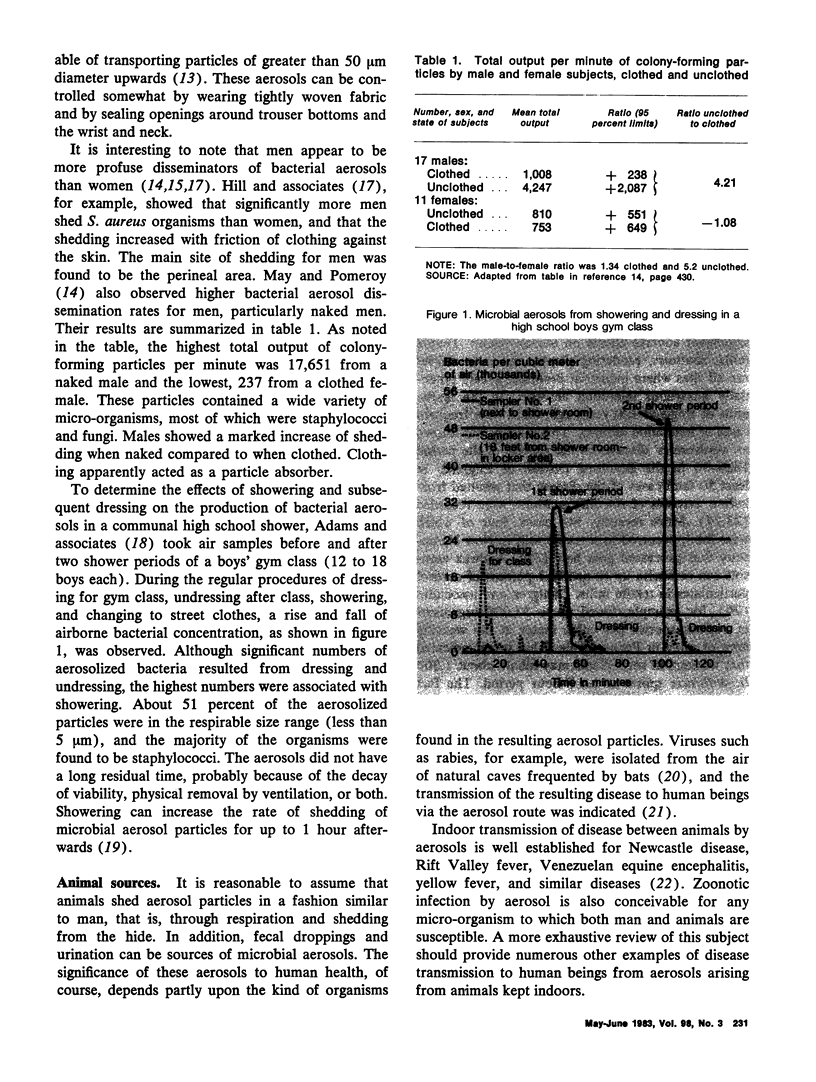
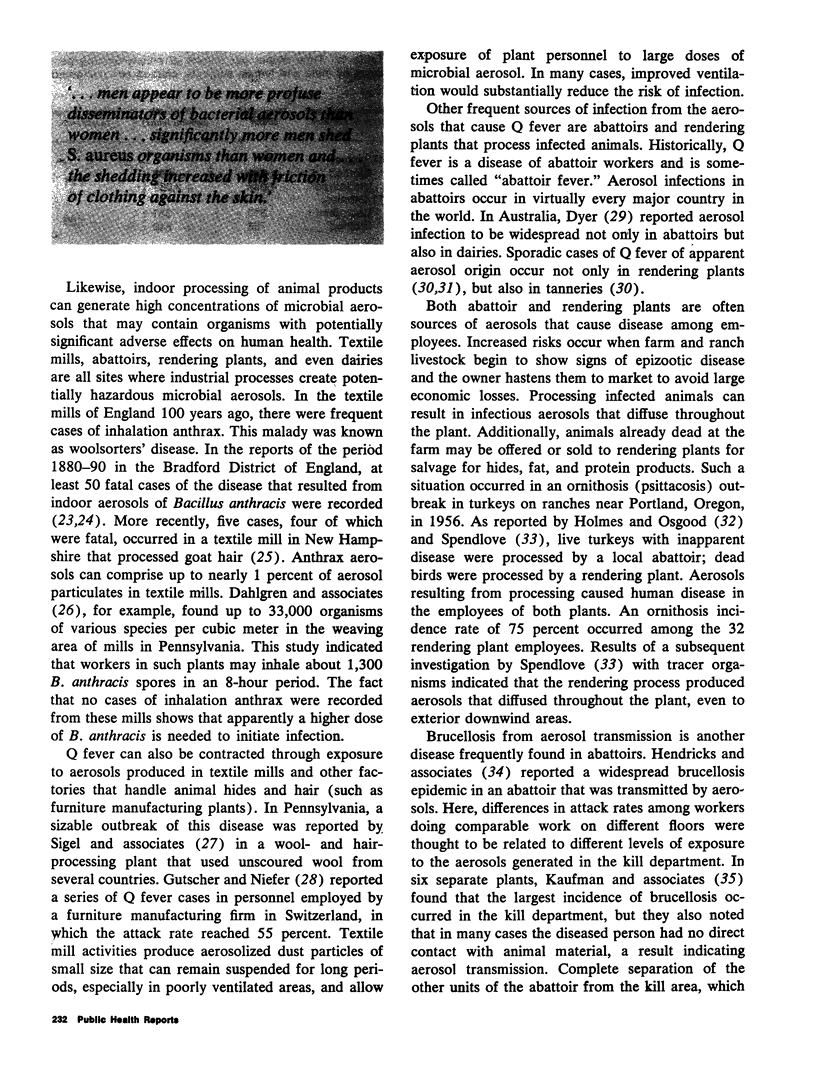
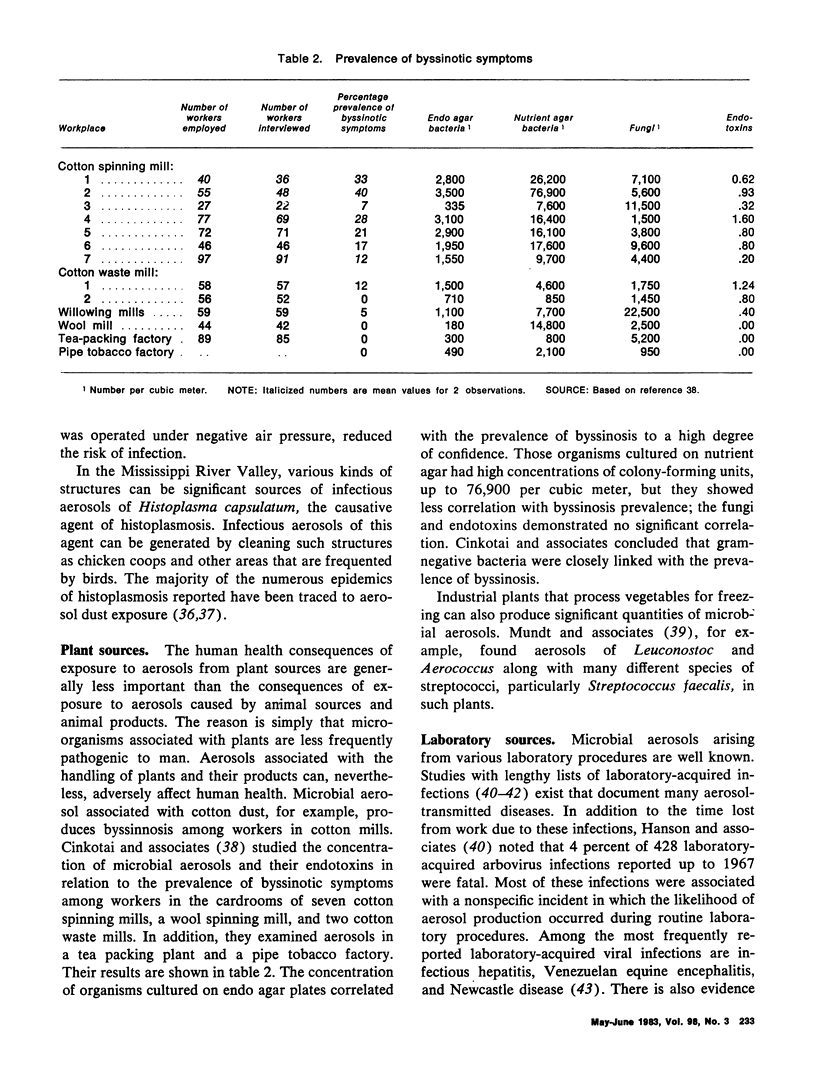
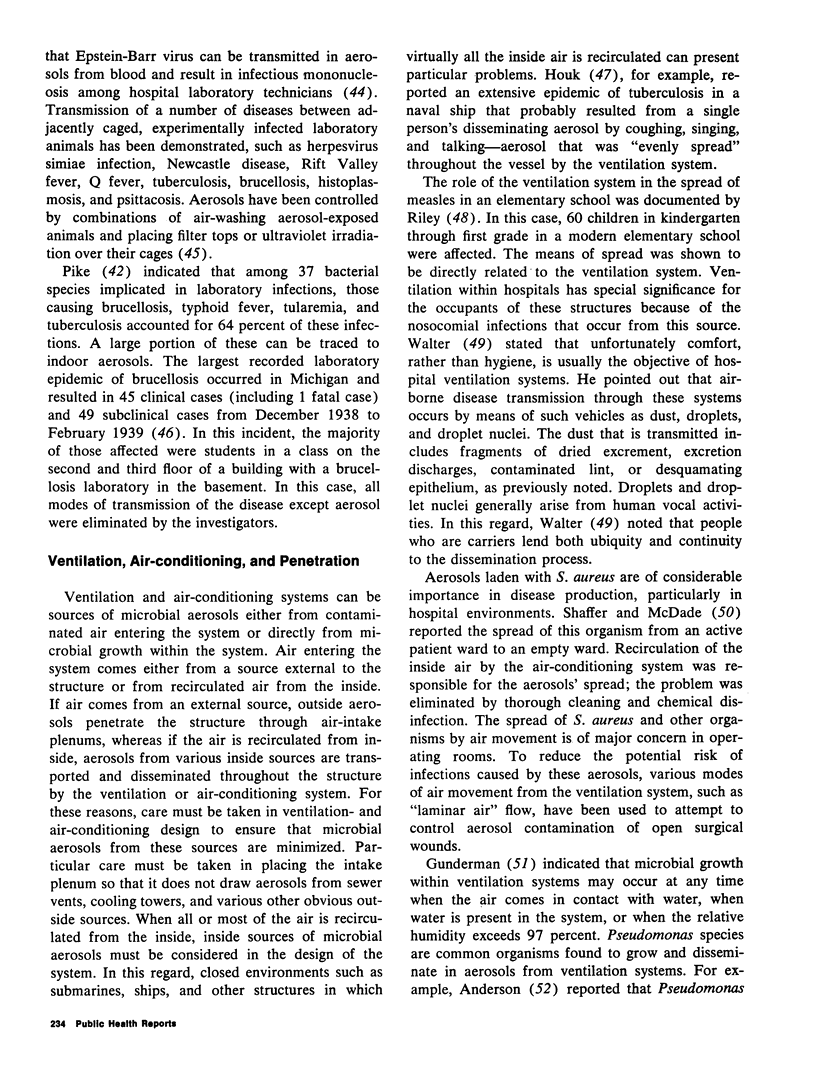
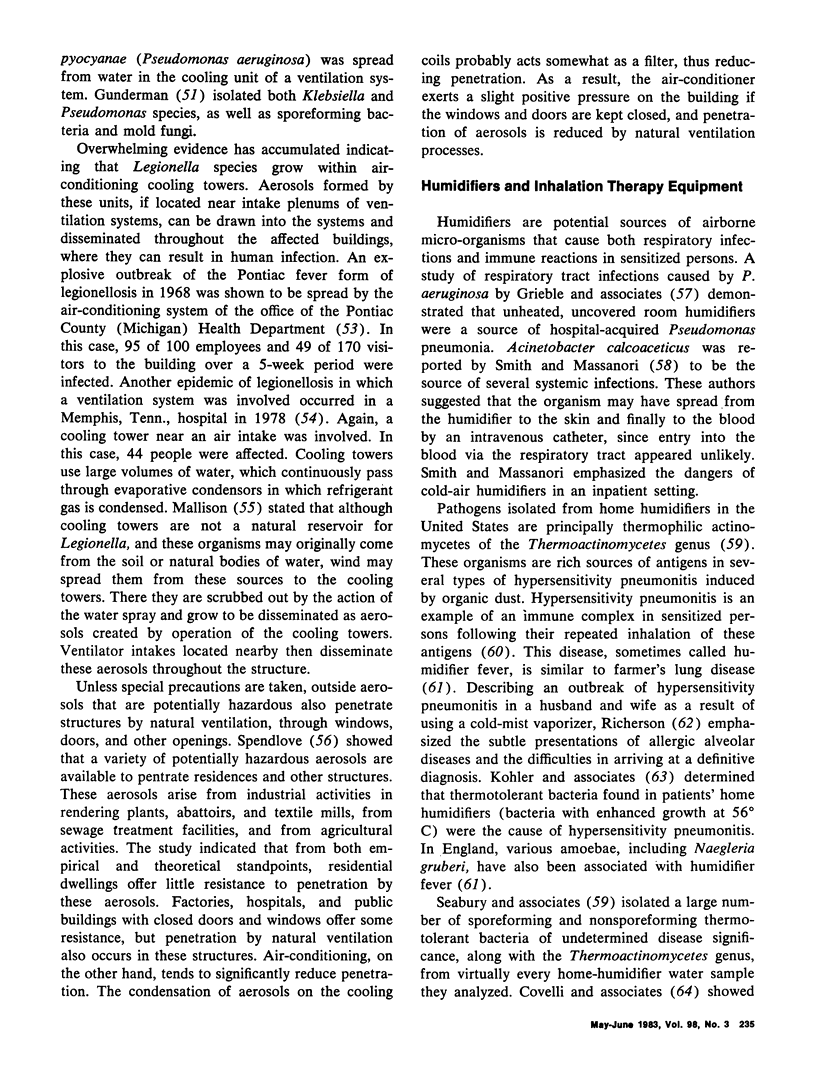
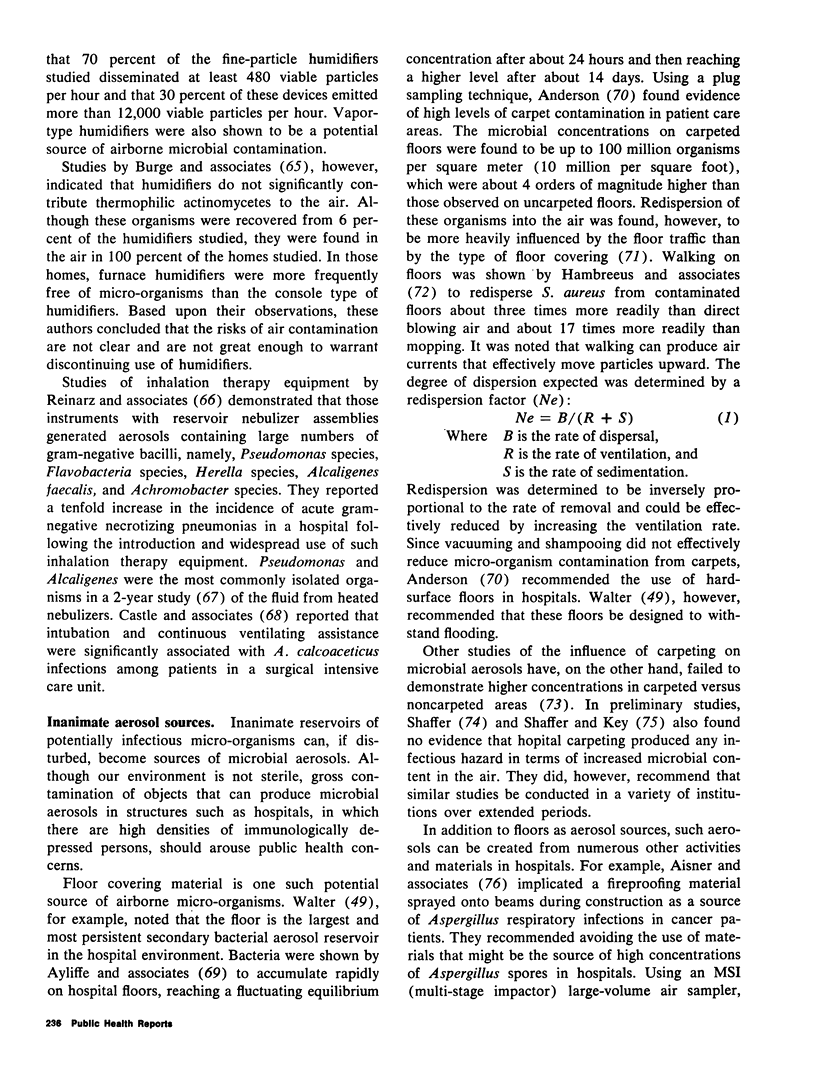


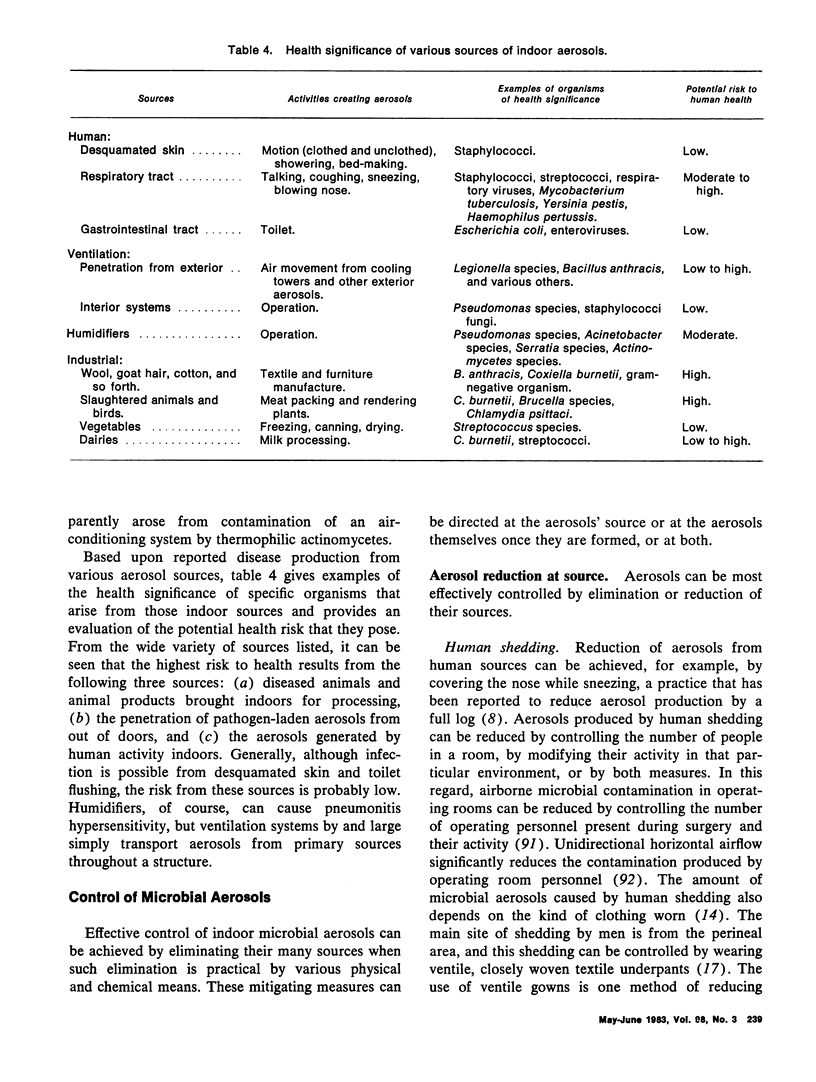
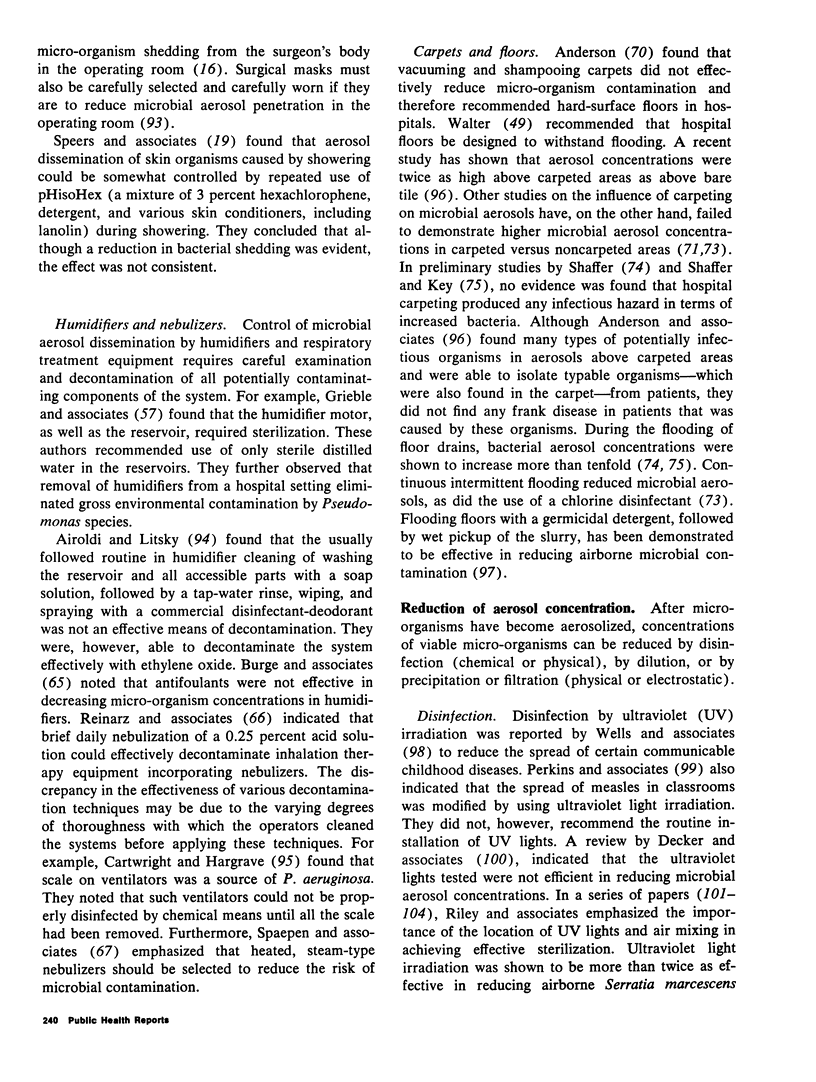
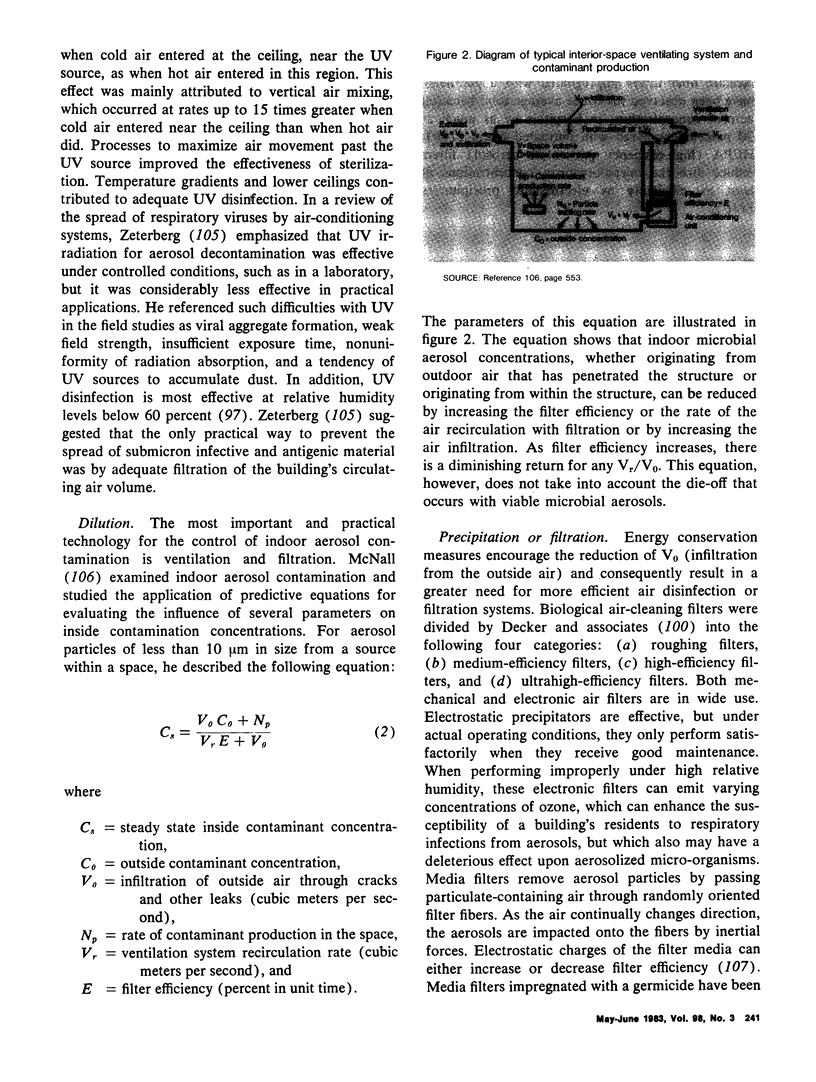
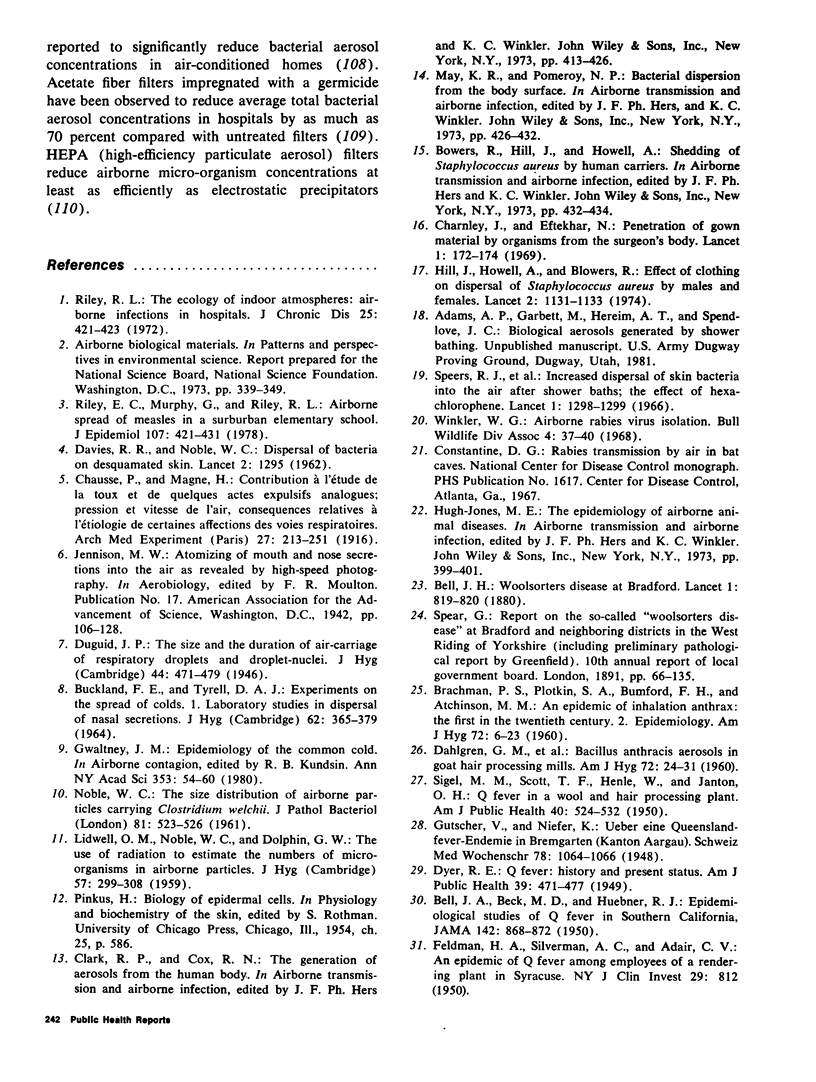
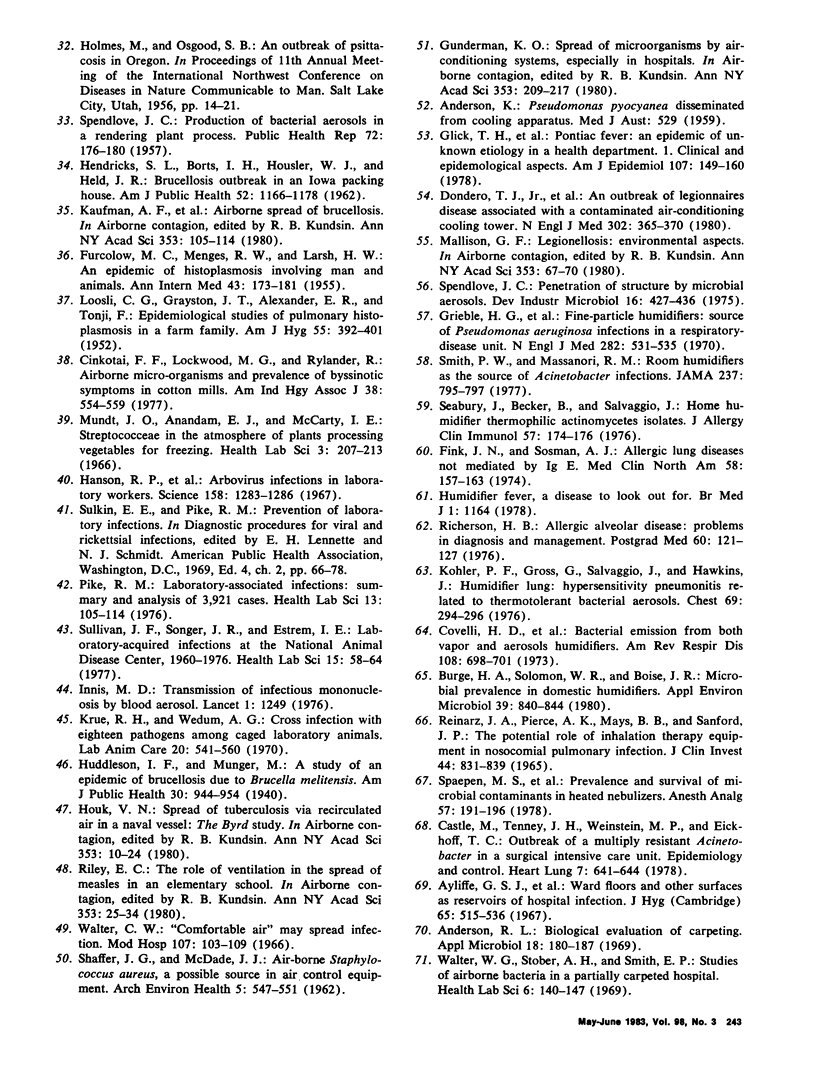
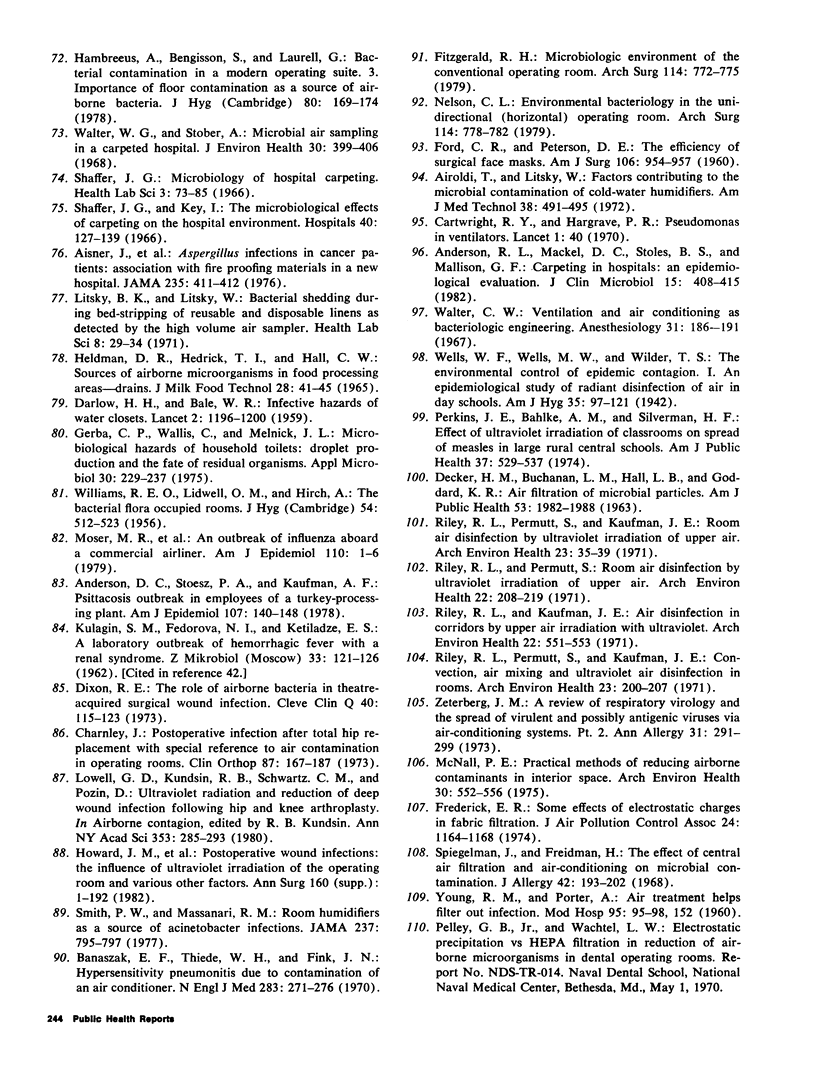
Selected References
These references are in PubMed. This may not be the complete list of references from this article.
- Airoldi T., Litsky W. Factors contributing to the microbial contamination of cold-water humidifiers. Am J Med Technol. 1972 Dec;38(12):491–495. [PubMed] [Google Scholar]
- Aisner J., Schimpff S. C., Bennett J. E., Young V. M., Wiernik P. H. Aspergillus infections in cancer patients. Association with fireproofing materials in a new hospital. JAMA. 1976 Jan 26;235(4):411–412. [PubMed] [Google Scholar]
- Anderson D. C., Stoesz P. A., Kaufmann A. F. Psittacosis outbreak in employees of a turkey-processing plant. Am J Epidemiol. 1978 Feb;107(2):140–148. doi: 10.1093/oxfordjournals.aje.a112516. [DOI] [PubMed] [Google Scholar]
- Anderson R. L. Biological evaluation of carpeting. Appl Microbiol. 1969 Aug;18(2):180–187. doi: 10.1128/am.18.2.180-187.1969. [DOI] [PMC free article] [PubMed] [Google Scholar]
- Anderson R. L., Mackel D. C., Stoler B. S., Mallison G. F. Carpeting in hospitals: an epidemiological evaluation. J Clin Microbiol. 1982 Mar;15(3):408–415. doi: 10.1128/jcm.15.3.408-415.1982. [DOI] [PMC free article] [PubMed] [Google Scholar]
- Ayliffe G. A., Collins B. J., Lowbury E. J., Babb J. R., Lilly H. A. Ward floors and other surfaces as reservoirs of hospital infection. J Hyg (Lond) 1967 Dec;65(4):515–536. doi: 10.1017/s0022172400046052. [DOI] [PMC free article] [PubMed] [Google Scholar]
- BELL J. A., BECK M. D., HUEBNER R. J. Epidemiologic studies of Q fever in southern California. J Am Med Assoc. 1950 Mar 25;142(12):868–872. doi: 10.1001/jama.1950.02910300006002. [DOI] [PubMed] [Google Scholar]
- BRACHMAN P. S., PLOTKIN S. A., BUMFORD F. H., ATCHISON M. M. An epidemic of inhalation anthrax: the first in the twentieth century. II. Epidemiology. Am J Hyg. 1960 Jul;72:6–23. doi: 10.1093/oxfordjournals.aje.a120135. [DOI] [PubMed] [Google Scholar]
- BUCKLAND F. E., TYRRELL D. A. EXPERIMENTS ON THE SPREAD OF COLDS. 1. LABORATORY STUDIES ON THE DISPERSAL OF NASAL SECRETION. J Hyg (Lond) 1964 Sep;62:365–377. doi: 10.1017/s0022172400040080. [DOI] [PMC free article] [PubMed] [Google Scholar]
- Banaszak E. F., Thiede W. H., Fink J. N. Hypersensitivity pneumonitis due to contamination of an air conditioner. N Engl J Med. 1970 Aug 6;283(6):271–276. doi: 10.1056/NEJM197008062830601. [DOI] [PubMed] [Google Scholar]
- Burge H. A., Solomon W. R., Boise J. R. Microbial prevalence in domestic humidifiers. Appl Environ Microbiol. 1980 Apr;39(4):840–844. doi: 10.1128/aem.39.4.840-844.1980. [DOI] [PMC free article] [PubMed] [Google Scholar]
- Cartwright R. Y., Hargrave P. R. Pseudomonas in ventilators. Lancet. 1970 Jan 3;1(7636):40–40. doi: 10.1016/s0140-6736(70)90553-2. [DOI] [PubMed] [Google Scholar]
- Castle M., Tenney J. H., Weinstein M. P., Eickhoff T. C. Outbreak of a multiply resistant Acinetobacter in a surgical intensive care unit: epidemiology and control. Heart Lung. 1978 Jul-Aug;7(4):641–644. [PubMed] [Google Scholar]
- Charnley J., Eftekhar N. Penetration of gown material by organisms from the surgeon's body. Lancet. 1969 Jan 25;1(7587):172–173. doi: 10.1016/s0140-6736(69)91188-x. [DOI] [PubMed] [Google Scholar]
- Charnley J. Postoperative infection after total hip replacement with special reference to air contamination in the operating room. Clin Orthop Relat Res. 1972 Sep;87:167–187. doi: 10.1097/00003086-197209000-00020. [DOI] [PubMed] [Google Scholar]
- Cinkotai F. F., Lockwood M. G., Rylander R. Airborne micro-organisms and prevalence of byssinotic symptoms in cotton mills. Am Ind Hyg Assoc J. 1977 Oct;38(10):554–559. doi: 10.1080/0002889778507669. [DOI] [PubMed] [Google Scholar]
- Covelli H. D., Kleeman J., Martin J. E., Landau W. L., Hughes R. L. Bacterial emission from both vapor and aerosol humidifiers. Am Rev Respir Dis. 1973 Sep;108(3):698–701. doi: 10.1164/arrd.1973.108.3.698. [DOI] [PubMed] [Google Scholar]
- DAHLGREN C. M., BUCHANAN L. M., DECKER H. M., FREED S. W., PHILLIPS C. R., BRACHMAN P. S. Bacillus anthracis aerosols in goat hair processing mills. Am J Hyg. 1960 Jul;72:24–31. doi: 10.1093/oxfordjournals.aje.a120131. [DOI] [PubMed] [Google Scholar]
- DARLOW H. M., BALE W. R. Infective hazards of water-closets. Lancet. 1959 Jun 6;1(7084):1196–1200. doi: 10.1016/s0140-6736(59)91201-2. [DOI] [PubMed] [Google Scholar]
- DAVIES R. R., NOBLE W. C. Dispersal of bacteria on desquamated skin. Lancet. 1962 Dec 22;2(7269):1295–1297. doi: 10.1016/s0140-6736(62)90849-8. [DOI] [PubMed] [Google Scholar]
- DECKER H. M., BUCHANAN L. M., HALL L. B., GODDARD K. R. AIR FILTRATION OF MICROBIAL PARTICLES. Am J Public Health Nations Health. 1963 Dec;53:1982–1988. doi: 10.2105/ajph.53.12.1982. [DOI] [PMC free article] [PubMed] [Google Scholar]
- DYER R. E. Q fever; history and present status. Am J Public Health Nations Health. 1949 Apr;39(4):471–477. doi: 10.2105/ajph.39.4.471. [DOI] [PMC free article] [PubMed] [Google Scholar]
- Dixon R. E. Clean air symposium. I. The role of airborne bacteria in theatre-acquired surgical wound infection. Cleve Clin Q. 1973 Fall;40(3):115–123. doi: 10.3949/ccjm.40.3.115. [DOI] [PubMed] [Google Scholar]
- Dondero T. J., Jr, Rendtorff R. C., Mallison G. F., Weeks R. M., Levy J. S., Wong E. W., Schaffner W. An outbreak of Legionnaires' disease associated with a contaminated air-conditioning cooling tower. N Engl J Med. 1980 Feb 14;302(7):365–370. doi: 10.1056/NEJM198002143020703. [DOI] [PubMed] [Google Scholar]
- FELDMAN H. A., SILVERMAN A. C., ADAIR V. An epidemic of Q fever among employees of a rendering plant in Syracuse, New York. J Clin Invest. 1950 Jun;29(6):812–812. [PubMed] [Google Scholar]
- FORD C. R., PETERSON D. E. THE EFFICIENCY OF SURGICAL FACE MASKS. Am J Surg. 1963 Dec;106:954–957. doi: 10.1016/0002-9610(63)90163-6. [DOI] [PubMed] [Google Scholar]
- FURCOLOW M. L., MENGES R. W., LARSH H. W. An epidemic of histoplasmosis involving man and animals. Ann Intern Med. 1955 Jul;43(1):173–181. doi: 10.7326/0003-4819-43-1-173. [DOI] [PubMed] [Google Scholar]
- Fink J. N., Sosman A. J. Allergic lung diseases not mediated by IgE. Med Clin North Am. 1974 Jan;58(1):157–163. doi: 10.1016/s0025-7125(16)32185-x. [DOI] [PubMed] [Google Scholar]
- Fitzgerald R. H., Jr Microbiologic environment of the conventional operating room. Arch Surg. 1979 Jul;114(7):772–775. doi: 10.1001/archsurg.1979.01370310014003. [DOI] [PubMed] [Google Scholar]
- Gerba C. P., Wallis C., Melnick J. L. Microbiological hazards of household toilets: droplet production and the fate of residual organisms. Appl Microbiol. 1975 Aug;30(2):229–237. doi: 10.1128/am.30.2.229-237.1975. [DOI] [PMC free article] [PubMed] [Google Scholar]
- Glick T. H., Gregg M. B., Berman B., Mallison G., Rhodes W. W., Jr, Kassanoff I. Pontiac fever. An epidemic of unknown etiology in a health department: I. Clinical and epidemiologic aspects. Am J Epidemiol. 1978 Feb;107(2):149–160. doi: 10.1093/oxfordjournals.aje.a112517. [DOI] [PubMed] [Google Scholar]
- Grieble H. G., Colton F. R., Bird T. J., Toigo A., Griffith L. G. Fine-particle humidifiers. Source of Pseudomonas aeruginosa infections in a respiratory-disease unit. N Engl J Med. 1970 Mar 5;282(10):531–535. doi: 10.1056/NEJM197003052821003. [DOI] [PubMed] [Google Scholar]
- Gwaltney J. M., Jr Epidemiology of the common cold. Ann N Y Acad Sci. 1980;353:54–60. doi: 10.1111/j.1749-6632.1980.tb18905.x. [DOI] [PubMed] [Google Scholar]
- HENDRICKS S. L., BORTS I. H., HEEREN R. H., HAUSLER W. J., HELD J. R. Brucellosis outbreak in an Iowa packing house. Am J Public Health Nations Health. 1962 Jul;52:1166–1178. doi: 10.2105/ajph.52.7.1166. [DOI] [PMC free article] [PubMed] [Google Scholar]
- HIRCH A., LIDWELL O. M., WILLIAMS R. E. The bacterial flora of the air of occupied rooms. J Hyg (Lond) 1956 Dec;54(4):512–523. doi: 10.1017/s002217240004479x. [DOI] [PMC free article] [PubMed] [Google Scholar]
- Hambraeus A., Bengtsson S., Laurell G. Bacterial contamination in a modern operating suite. 3. Importance of floor contamination as a source of airborne bacteria. J Hyg (Lond) 1978 Apr;80(2):169–174. doi: 10.1017/s0022172400053511. [DOI] [PMC free article] [PubMed] [Google Scholar]
- Hanson R. P., Sulkin S. E., Beuscher E. L., Hammon W. M., McKinney R. W., Work T. H. Arbovirus infections of laboratory workers. Extent of problem emphasizes the need for more effective measures to reduce hazards. Science. 1967 Dec 8;158(3806):1283–1286. doi: 10.1126/science.158.3806.1283. [DOI] [PubMed] [Google Scholar]
- Hill J., Howell A., Blowers R. Effect of clothing on dispersal of Staphylococcus aureus by males and females. Lancet. 1974 Nov 9;2(7889):1131–1133. doi: 10.1016/s0140-6736(74)90885-x. [DOI] [PubMed] [Google Scholar]
- Houk V. N. Spread of tuberculosis via recirculated air in a naval vessel: the Byrd study. Ann N Y Acad Sci. 1980;353:10–24. doi: 10.1111/j.1749-6632.1980.tb18901.x. [DOI] [PubMed] [Google Scholar]
- Huddleson I. F., Munger M. A Study of an Epidemic of Brucellosis Due to Brucella melitensis. Am J Public Health Nations Health. 1940 Aug;30(8):944–954. doi: 10.2105/ajph.30.8.944. [DOI] [PMC free article] [PubMed] [Google Scholar]
- Innis M. D. Letter: Transmission of infectious mononucleosis by blood aerosol? Lancet. 1976 Jun 5;1(7971):1249–1249. doi: 10.1016/s0140-6736(76)92208-x. [DOI] [PubMed] [Google Scholar]
- Kohler P. F., Gross G., Salvaggio J., Hawkins J. Humidifier lung: hypersensitivity pneumonitis related to thermotolerant bacterial aerosols. Chest. 1976 Feb;69(2 Suppl):294–296. [PubMed] [Google Scholar]
- Kruse R. H., Wedum A. G. Cross infection with eighteen pathogens among caged laboratory animals. Lab Anim Care. 1970 Jun;20(3):541–560. [PubMed] [Google Scholar]
- LIDWELL O. M., NOBLE W. C., DOLPHIN G. W. The use of radiation to estimate the numbers of micro-organisms in airborne particles. J Hyg (Lond) 1959 Sep;57:299–308. doi: 10.1017/s0022172400020167. [DOI] [PMC free article] [PubMed] [Google Scholar]
- LOOSLI C. G., GRAYSTON J. T., ALEXANDER E. R., TANZI F. Epidemiological studies of pulmonary histoplasmosis in a farm family. Am J Hyg. 1952 May;55(3):392–401. doi: 10.1093/oxfordjournals.aje.a119531. [DOI] [PubMed] [Google Scholar]
- Litsky B. Y., Litsky W. Bacterial shedding during bed-stripping of reusable and disposable linens as detected by the high volume air sampler. Health Lab Sci. 1971 Jan;8(1):29–34. [PubMed] [Google Scholar]
- Lowell J. D., Kundsin R. B., Schwartz C. M., Pozin D. Ultraviolet radiation and reduction of deep wound infection following hip and knee arthroplasty. Ann N Y Acad Sci. 1980;353:285–293. doi: 10.1111/j.1749-6632.1980.tb18931.x. [DOI] [PubMed] [Google Scholar]
- Mallison G. F. Legionellosis: environmental aspects. Ann N Y Acad Sci. 1980;353:67–70. doi: 10.1111/j.1749-6632.1980.tb18907.x. [DOI] [PubMed] [Google Scholar]
- McNall R. E., Jr Practical methods of reducing airborne contaminants in interior spaces. Arch Environ Health. 1975 Nov;30(11):552–558. doi: 10.1080/00039896.1975.10666774. [DOI] [PubMed] [Google Scholar]
- Moser M. R., Bender T. R., Margolis H. S., Noble G. R., Kendal A. P., Ritter D. G. An outbreak of influenza aboard a commercial airliner. Am J Epidemiol. 1979 Jul;110(1):1–6. doi: 10.1093/oxfordjournals.aje.a112781. [DOI] [PubMed] [Google Scholar]
- Mundt J. O., Anandam E. J., McCarty I. E. Streptococceae in the atmosphere of plants processing vegetables for freezing. Health Lab Sci. 1966 Oct;3(4):207–213. [PubMed] [Google Scholar]
- NOBLE W. C. The size distribution of airborne particles carrying Clostridium welchii. J Pathol Bacteriol. 1961 Apr;81:523–526. doi: 10.1002/path.1700810225. [DOI] [PubMed] [Google Scholar]
- Nelson C. L. Environmental bacteriology in the unidirectional (horizontal) operating room. Arch Surg. 1979 Jul;114(7):778–782. doi: 10.1001/archsurg.1979.01370310020004. [DOI] [PubMed] [Google Scholar]
- Perkins J. E., Bahlke A. M., Silverman H. F. Effect of Ultra-violet Irradiation of Classrooms on Spread of Measles in Large Rural Central Schools Preliminary Report. Am J Public Health Nations Health. 1947 May;37(5):529–537. [PMC free article] [PubMed] [Google Scholar]
- Pike R. M. Laboratory-associated infections: summary and analysis of 3921 cases. Health Lab Sci. 1976 Apr;13(2):105–114. [PubMed] [Google Scholar]
- REINARZ J. A., PIERCE A. K., MAYS B. B., SANFORD J. P. THE POTENTIAL ROLE OF INHALATION THERAPY EQUIPMENT IN NOSOCOMIAL PULMONARY INFECTION. J Clin Invest. 1965 May;44:831–839. doi: 10.1172/JCI105195. [DOI] [PMC free article] [PubMed] [Google Scholar]
- Richerson H. B. Allergic alveolar diseases. Problems in diagnosis and management. Postgrad Med. 1976 Sep;60(9):121–127. [PubMed] [Google Scholar]
- Riley E. C., Murphy G., Riley R. L. Airborne spread of measles in a suburban elementary school. Am J Epidemiol. 1978 May;107(5):421–432. doi: 10.1093/oxfordjournals.aje.a112560. [DOI] [PubMed] [Google Scholar]
- Riley E. C. The role of ventilation in the spread of measles in an elementary school. Ann N Y Acad Sci. 1980;353:25–34. doi: 10.1111/j.1749-6632.1980.tb18902.x. [DOI] [PubMed] [Google Scholar]
- Riley R. L., Kaufman J. E. Air disinfection in corridors by upper air irradiation with ultraviolet. Arch Environ Health. 1971 May;22(5):551–553. doi: 10.1080/00039896.1971.10665899. [DOI] [PubMed] [Google Scholar]
- Riley R. L., Permutt S., Kaufman J. E. Convection, air mixing, and ultraviolet air disinfection in rooms. Arch Environ Health. 1971 Feb;22(2):200–207. doi: 10.1080/00039896.1971.10665833. [DOI] [PubMed] [Google Scholar]
- Riley R. L., Permutt S., Kaufman J. E. Room air disinfection by ultraviolet irradiation of upper air. Further analysis of convective air exchange. Arch Environ Health. 1971 Jul;23(1):35–39. doi: 10.1080/00039896.1971.10665951. [DOI] [PubMed] [Google Scholar]
- Riley R. L., Permutt S. Room air disinfection by ultraviolet irradiation of upper air. Air mixing and germicidal effectiveness. Arch Environ Health. 1971 Feb;22(2):208–219. doi: 10.1080/00039896.1971.10665834. [DOI] [PubMed] [Google Scholar]
- Riley R. L. The ecology of indoor atmospheres: airborne infection in hospitals. J Chronic Dis. 1972 Aug;25(8):421–423. doi: 10.1016/0021-9681(72)90204-4. [DOI] [PubMed] [Google Scholar]
- SHAFFER J. G., McDADE J. J. Air-borne Staphylococcus aureus. A possible source in air control equipment. Arch Environ Health. 1962 Dec;5:547–551. doi: 10.1080/00039896.1962.10663329. [DOI] [PubMed] [Google Scholar]
- SIGEL M. M., SCOTT T. F. M., HENLE W., JANTON O. H. Q fever in a wool and hair processing plant. Am J Public Health Nations Health. 1950 May;40(5):524–532. doi: 10.2105/ajph.40.5.524. [DOI] [PMC free article] [PubMed] [Google Scholar]
- SPENDLOVE J. C. Production of bacterial aerosols in a rendering plant process. Public Health Rep. 1957 Feb;72(2):176–180. [PMC free article] [PubMed] [Google Scholar]
- Seabury J., Becker B., Salvaggio J. Home humidifier thermophilic actinomycete isolates. J Allergy Clin Immunol. 1976 Feb;57(2):174–176. doi: 10.1016/0091-6749(76)90037-3. [DOI] [PubMed] [Google Scholar]
- Shaffer J. G., Key I. The microbiological effects of carpeting on the hospital environment. Hospitals. 1966 Nov 16;40(22):126–139. [PubMed] [Google Scholar]
- Shaffer J. G. Microbiology of hospital carpeting. Health Lab Sci. 1966 Apr;3(2):73–85. [PubMed] [Google Scholar]
- Smith P. W., Massanari R. M. Room humidifiers as the source of Acinetobacter infections. JAMA. 1977 Feb 21;237(8):795–797. [PubMed] [Google Scholar]
- Smith P. W., Massanari R. M. Room humidifiers as the source of Acinetobacter infections. JAMA. 1977 Feb 21;237(8):795–797. [PubMed] [Google Scholar]
- Spaepen M. S., Berryman J. R., Bodman H. A., Kundsin R. B., Fencl V. Prevalence and survival of microbial contaminants in heated nebulizers. Anesth Analg. 1978 Mar-Apr;57(2):191–196. doi: 10.1213/00000539-197803000-00008. [DOI] [PubMed] [Google Scholar]
- Speers R., Jr, O'Grady F. W., Shooter R. A., Bernard H. R., Cole W. R. Increased dispersal of skin bacteria into the air after shower baths: the effect of hexachlorophene. Lancet. 1966 Jun 11;1(7450):1298–1299. doi: 10.1016/s0140-6736(66)91203-7. [DOI] [PubMed] [Google Scholar]
- Sullivan J. F., Songer J. R., Estrem I. E. Laboratory-acquired infections at the National Animal Disease Center 1960--1976. Health Lab Sci. 1978 Jan;15(1):58–64. [PubMed] [Google Scholar]
- Walter C. W. "Comfortable air" may spread infection. Mod Hosp. 1966 Oct;107(4):103–passim. [PubMed] [Google Scholar]
- Walter C. W. Ventilation and air conditioning as bacteriologic engineering. Anesthesiology. 1969 Aug;31(2):186–192. doi: 10.1097/00000542-196908000-00012. [DOI] [PubMed] [Google Scholar]
- Walter W. G., Stober A. H., Smith E. P. Studies of airborne bacteria in a partially carpeted hospital. Health Lab Sci. 1969 Jul;6(3):140–147. [PubMed] [Google Scholar]
- Winkler W. G. Airborne rabies virus isolation. Wildl Dis. 1968 Apr;4(2):37–40. doi: 10.7589/0090-3558-4.2.37. [DOI] [PubMed] [Google Scholar]
- Zeterberg J. M. A review of respiratory virology and the spread of virulent and possibly antigenic viruses via air conditioning systems. II. Ann Allergy. 1973 Jun;31(6):291–299. [PubMed] [Google Scholar]


